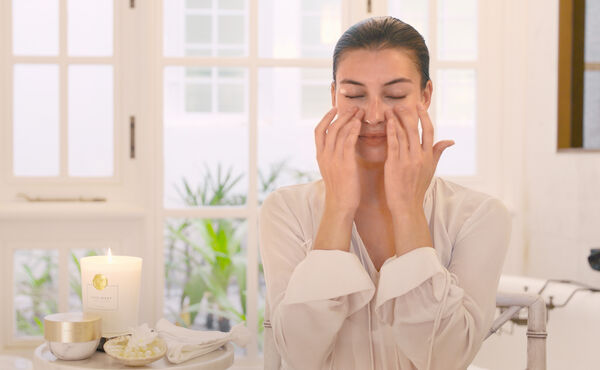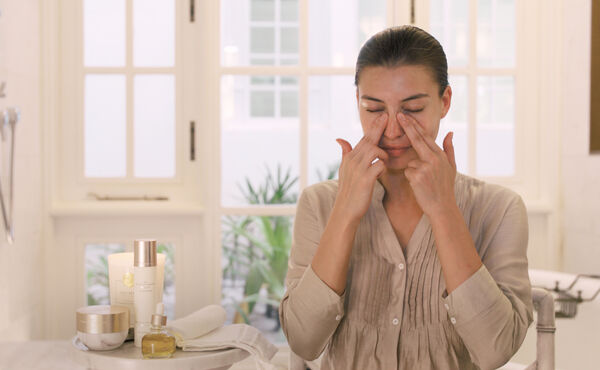Face mapping, or “mien shiang”, is an ancient Chinese practice. It’s a zone-by-zone skin analysis based on the idea that blemishes on the face can reveal underlying health issues. Skincare expert Abigail James explains how it works.
There is some controversy surrounding how true face mapping is. A western medical doctor would argue that it’s not possible to determine your body’s internal health by looking at certain areas of the face. However, a trained acupuncturist, naturopath, or ayurvedic doctor would beg to differ.
Our faces reveal so much about us, including many emotions. You can look at someone and immediately see whether they are sad, stressed, angry or happy. These different expressions are formed by what’s underneath the skin—muscles, tissues, blood flow, fluids and nerves. These are not just connected to our faces, but to the whole bodily system.
What does your skin tell you about your health?
According to many ancient therapies, such as Ayurveda and Traditional Chinese Medicine (TCM), specific areas of the face relate to different internal organs and systems. This means that any skin concerns present on areas of the face—including breakouts, redness, dry patches, swelling and deep wrinkles—may be caused by deeper underlying issues or internal imbalances connected with organs, systems and emotions inside the body. That’s not to say that a breakout in a particular area indicates a specific problem with an organ—each organ has specific emotional connections.
-
Lower cheeks
The lower cheeks, for example, relate to the lung meridian. But if you suffer from recurring spots there, it doesn’t necessarily mean that you have a problem with your respiratory system. The lung meridian has an emotional association and the breakouts may be caused by grief, anxiety, lack of self-esteem or depleted energy levels. If home products don’t seem to be doing the trick, you may find TCM helps you to identify the root cause of your problem.
-
Forehead
The forehead is connected to general digestive issues, bad diet, too much sugar, bad fats, excess rich foods and not enough water. When there is an internal food allergy, I often see small, under-the-skin pimples spread across this whole area.
-
Chin & jaw
The chin and jaw area are connected to the hormonal system, with the ovaries positioned either side of the mouth on the chin. Often you may break out on one side, which may indicate the side on which you are ovulating. White spots on the chin, blotchy patches or a red chin can indicate too much sugar and gut candida. Spots to the side of the chin can also be related to the colon.
How do you get rid of skin blemishes?
If you break out in the same area again and again, or deeper wrinkles appear in a specific area, the cause may be an emotional imbalance that diet and products alone can’t budge.
General facial massage and acupressure point massage are great for providing holistic support. I particularly love to use the ageless night balm for this type of massage in the evening. It always feels lovely after a gentle exfoliation. Always apply a splash of first essence, which contains fermented black tea and helps restore the acid mantle of all skin types.
I love supporting the body internally and I’m a huge fan of teas. The Ritual of Hammam organic green tea with mint is particularly good. A number of skin issues are closely connected to the gut and liver. The combination of antioxidants and gut-calming peppermint is ideal no matter what your skin concern is.
If your concern is breakouts and redness, this is often caused by internal inflammation. Cutting back on refined sugars, caffeine, alcohol and cow’s milk all help to reduce this. Also, adding in turmeric which is a natural anti-inflammatory and supports your gut. I would also recommend kefir for probiotic gut support and saurcraut, which is a naturally fermented food full of gut-friendly bacteria. I also love chlorella, which can be added to juices and smoothies or taken as a stand-alone food supplement.

_BW.jpg?sw=600&sh=370&sm=fit&cx=267&cy=204&cw=2546&ch=1570&sfrm=jpg)
.jpg?sw=600&sh=370&sm=fit&cx=105&cy=0&cw=876&ch=540&sfrm=jpg)

.jpg?sw=600&sh=370&sm=fit&cx=0&cy=0&cw=600&ch=370&sfrm=jpg)
.jpg?sw=600&sh=370&sm=fit&cx=0&cy=226&cw=8693&ch=5361&sfrm=jpg)



.jpg?sw=600&sh=370&sm=fit&cx=0&cy=0&cw=600&ch=370&sfrm=jpg)
